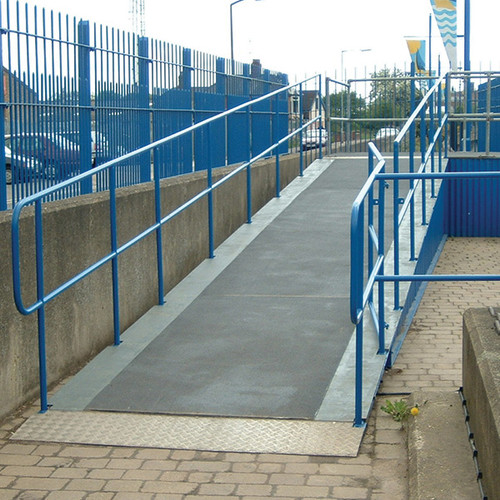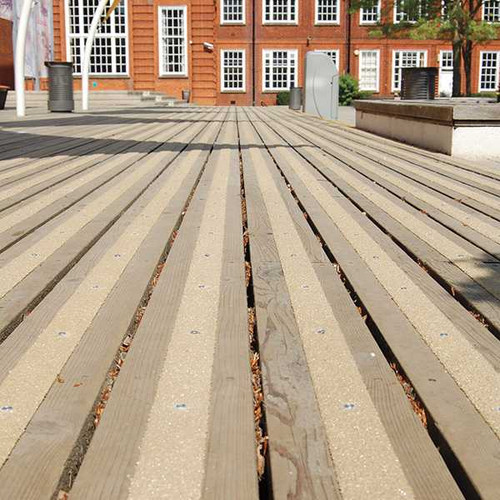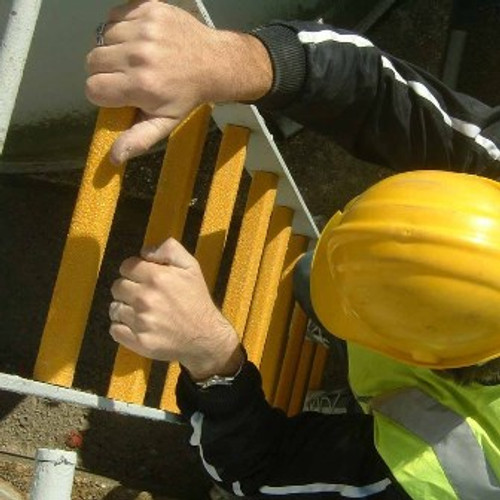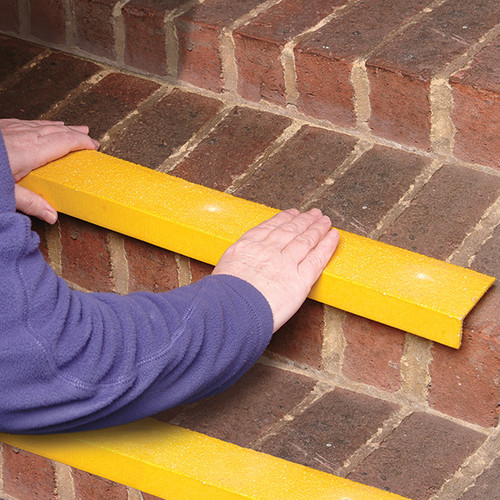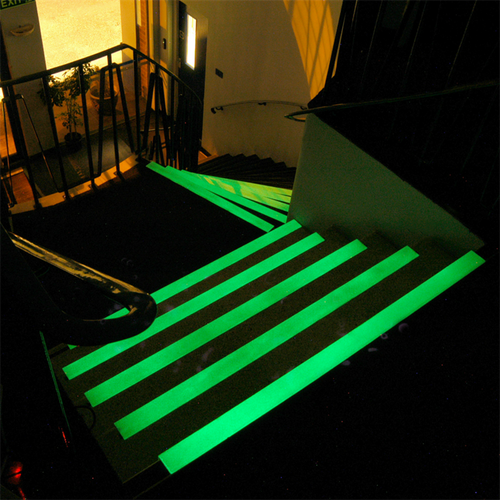Product Detail
Fiberglass (FRP) anti slip step covers are tough and have slip-resistant tread and nosing. They are used on both interior and exterior applications and are suitable for concrete, wood, brick, stone and metal. FRP non slip stair tread covers are black with yellow nosing for quick and easy identification.
Features and Benefits of FRP Non-Slip Step Covers:
- Excellent slip resistance, even when wet
- Convenient and versatile, easy to install
- Extremely tough, corrosion-resistant fiberglass base with resin-bonded surface
- 2¼" high visibility yellow nosing for improved safety
- 16 standard sizes available
- Oil and chemical resistant
- Will not rot or warp
- Easy slip-free solution for slippery steps and bleachers
- Ideal for wet or weak substrates which cannot be adequately prepared for paint
- Attach by screw and Mastic Adhesive ChemLink M-1 to any reasonably dry surface
- Refer to the product specifications for installation instructions
Specifications
| Usage Interior/Exterior: | Interior or Exterior |
| Primer Required: | Optional |
| Suitable for: | Concrete, wood, brick, stone and metal |
How to Apply
The FRP range can be glued to any reasonably dry surface using Mastic Adhesive ChemLink M-1. A thick bead of mastic will also help prevent 'rocking' on an uneven surface. As a guide, one 10 oz. tube of Mastic Adhesive is sufficient for any one of the following:
- (5) - 24" wide Step Covers
- (5) - 32" wide Step Covers
- (3) - 36" wide Step Covers
- (2) - 59" wide Step Covers
- (2) - 47-1/4" Landing Covers
Surface Preparation
The surface should be reasonably clean and dry if the Mastic Adhesive ChemLink M-1 is to be the only means of attaching the FRP to the substrate. Badly damaged concrete should be repaired before installing any Fiberglass products. The Mastic Adhesive can tolerate minor imperfections in the concrete. If the surface is too damp, dirty, or unsound or the surface is in very cold weather, use Mastic Adhesive to bed the FRP item into place and then supplement with screws. Install screws about 2 feet apart. Drilling through the FRP is easy using a standard twist drill suitable for wood or metal. Countersinking is not required. If you need to cut the FRP product, a good quality abrasive disc, jigsaw or hacksaw can be used. The FRP material is quite tough to cut by hand, so if power tools are not readily available, please ask about our cut to size service.
Screw Size Guide
- To timber: No.8 x 30mm zinc plated or stainless steel screws.
- To steel plate: No.8 x 20mm self-tapping pan head stainless steel screws or No.8 x 20mm self drilling pan head Philips zinc plated screws.
- To concrete: No.8 x 30mm zinc plated or stainless steel impact anchors.
- To open mesh: Stainless steel or zinc plated saddle clips and domed head bolts suitable in length for the depth of the existing treads.
Application
Pre-position the piece of FRP in place to ensure the fit. Trim if needed. Install screws about 6 inches from the ends of the piece, then additional screws every 2 feet as needed. Pre-drill the FRP to the proper hole size for the screws being used.
Data Sheet
Fiberglass (FRP) anti slip step covers are tough and have slip-resistant tread and nosing. They are used on both interior and exterior applications and are suitable for concrete, wood, brick, stone and metal. FRP non slip stair tread covers are black with yellow nosing for quick and easy identification.
Features and Benefits of FRP Non-Slip Step Covers:
- Excellent slip resistance, even when wet
- Convenient and versatile, easy to install
- Extremely tough, corrosion-resistant fiberglass base with resin-bonded surface
- 2¼" high visibility yellow nosing for improved safety
- 16 standard sizes available
- Oil and chemical resistant
- Will not rot or warp
- Easy slip-free solution for slippery steps and bleachers
- Ideal for wet or weak substrates which cannot be adequately prepared for paint
- Attach by screw and Mastic Adhesive ChemLink M-1 to any reasonably dry surface
- Refer to the product specifications for installation instructions
| Usage Interior/Exterior: | Interior or Exterior |
| Primer Required: | Optional |
| Suitable for: | Concrete, wood, brick, stone and metal |
The FRP range can be glued to any reasonably dry surface using Mastic Adhesive ChemLink M-1. A thick bead of mastic will also help prevent 'rocking' on an uneven surface. As a guide, one 10 oz. tube of Mastic Adhesive is sufficient for any one of the following:
- (5) - 24" wide Step Covers
- (5) - 32" wide Step Covers
- (3) - 36" wide Step Covers
- (2) - 59" wide Step Covers
- (2) - 47-1/4" Landing Covers
Surface Preparation
The surface should be reasonably clean and dry if the Mastic Adhesive ChemLink M-1 is to be the only means of attaching the FRP to the substrate. Badly damaged concrete should be repaired before installing any Fiberglass products. The Mastic Adhesive can tolerate minor imperfections in the concrete. If the surface is too damp, dirty, or unsound or the surface is in very cold weather, use Mastic Adhesive to bed the FRP item into place and then supplement with screws. Install screws about 2 feet apart. Drilling through the FRP is easy using a standard twist drill suitable for wood or metal. Countersinking is not required. If you need to cut the FRP product, a good quality abrasive disc, jigsaw or hacksaw can be used. The FRP material is quite tough to cut by hand, so if power tools are not readily available, please ask about our cut to size service.
Screw Size Guide
- To timber: No.8 x 30mm zinc plated or stainless steel screws.
- To steel plate: No.8 x 20mm self-tapping pan head stainless steel screws or No.8 x 20mm self drilling pan head Philips zinc plated screws.
- To concrete: No.8 x 30mm zinc plated or stainless steel impact anchors.
- To open mesh: Stainless steel or zinc plated saddle clips and domed head bolts suitable in length for the depth of the existing treads.
Application
Pre-position the piece of FRP in place to ensure the fit. Trim if needed. Install screws about 6 inches from the ends of the piece, then additional screws every 2 feet as needed. Pre-drill the FRP to the proper hole size for the screws being used.







